
When contacting us by e-mail, correspondents are asked to include their name and full postal address and, when providing information, to quote exact book and magazine sources. The word ‘chess’ needs to appear in the subject-line or in the message itself.
| First column | << previous | Archives [24] | next >> | Current column |
How often has chess been the main front-page story in a newspaper? Here is one instance, from the Journal de Genève et Gazette de Lausanne of 10 April 1997:

The news report concerned Kasparov’s involvement with the Swiss company Audemars Piguet in the development of a clock for use in his upcoming match against Deep Blue.
From Leonard Barden (London):
‘Although it is only incidentally relevant to John Donaldson’s query, I would mention that his reference to Frank Anderson as a gold medallist at the 1954 Olympiad needs qualification.
Amsterdam hosted the 1954 Olympiad at a few weeks’ notice when Buenos Aires, the scheduled venue, withdrew owing to financial irregularities within the Argentine Chess Federation. The Dutch organizers did a splendid job in the circumstances, but inevitably a few details were overlooked in the rush. So board prizes were forgotten until late in the day and, in at least some cases, were hastily-purchased mementoes. For his exceptional result on board two, Frank Anderson received a handled copper or pewter jug, about one foot high and with several dents.
He was one of the most likeable and pleasant chessplayers I have ever met. He went around on crutches, but made light of his disability. We became friends during that Olympiad, and, on his way back to Canada, he stopped over in London and visited my house. There he produced the jug and explained that he did not really care for it and that it would increase his excess luggage charge if he took it on the flight home. So he left it with me, and it resided on my mantelpiece for more than 30 years.
In the mid-1980s I heard that John G. Prentice of the Chess Federation of Canada planned to create a national chess museum of historical items. Prentice was a FIDE official and came to London for the 1986 world title match between Kasparov and Karpov. There I presented him with Anderson’s award. I recall that I was thrilled at my service to chess history, but that Prentice looked disappointed. He died the following year, and I still do not know if the museum ever took off or whether Frank Anderson’s board prize has survived. Perhaps one of your Canadian readers could provide some information.’
Geoff Chandler (Edinburgh) has been doing some hunting on possible connections between chess and the British writer Enid Blyton (1897-1968), and has forwarded us a passage from page 55 of her autobiography (written for children), The Story of My Life (London, 1952):
‘When I was six my father taught me to play draughts, and a little later he taught me to play chess. That was just before I was seven. He thought that all young children should learn to play chess. “If they have any brains it will train them to think clearly, quickly and to plan things a long way ahead”, he said. “And if they haven’t any brains it will make the best of those they have!” I don’t know if he was right. I know that I enjoyed the games immensely. Children rarely play chess now. There is not enough time, and chess is a game that takes up a very great deal of time. I wonder if any of you who are reading this book can play chess.’
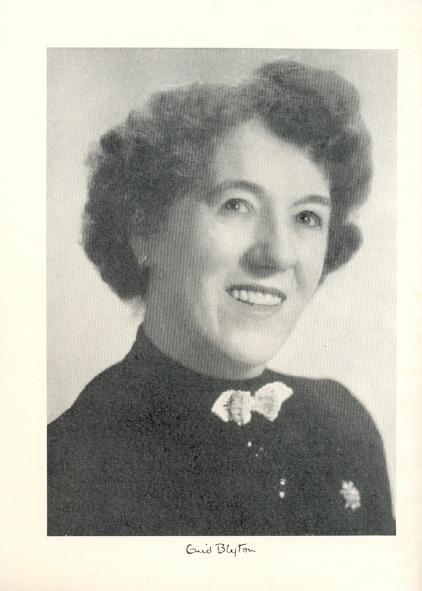
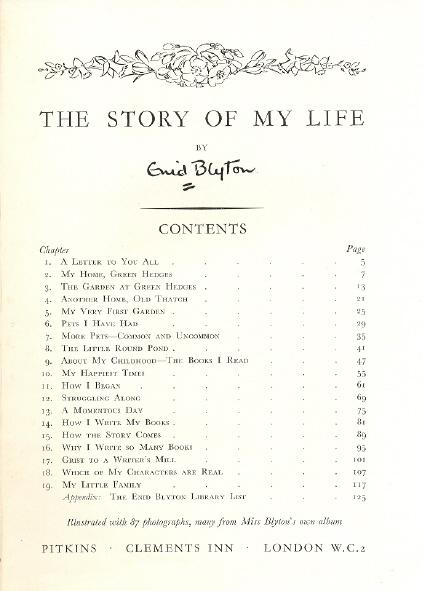
Below is a well-known group photograph from San Sebastián, 1911:
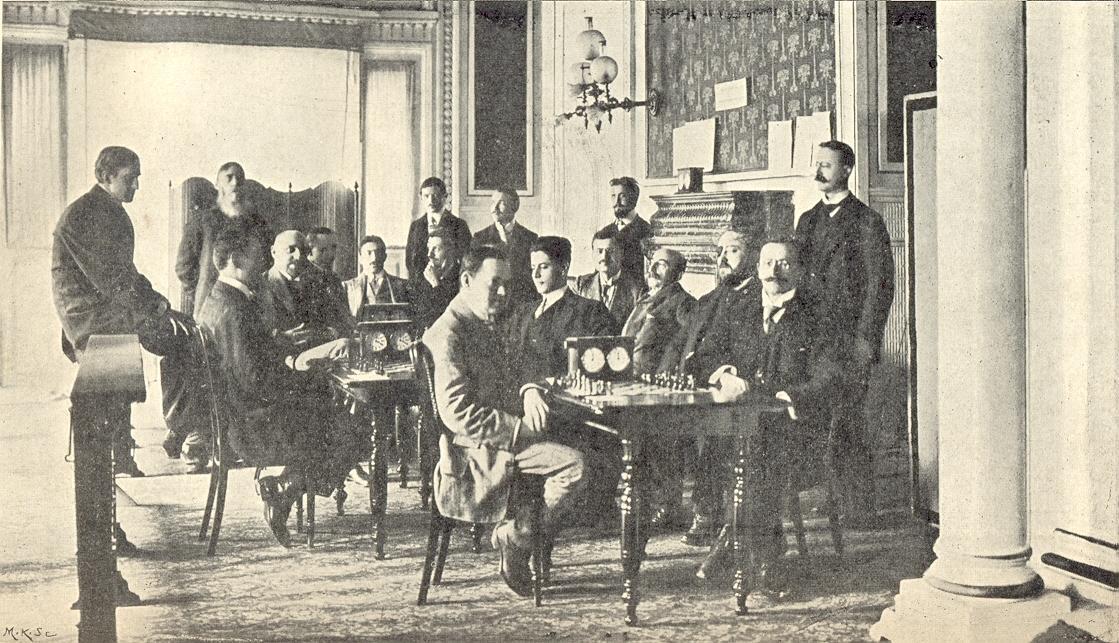
The challenge to readers is to identify everyone. That may seem straightforward, but we wonder whether anybody will be successful.
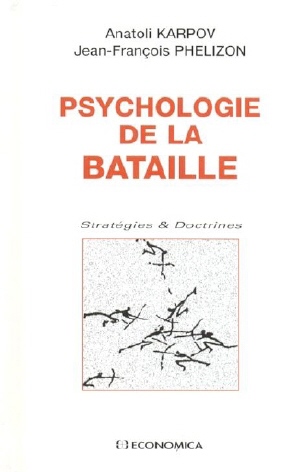
Psychologie de la bataille by A. Karpov and J.-F. Phelizon (Paris, 2004) is due to appear in an English edition in 2006, under the title Chess and the Art of Negotiation. It must be hoped that more care will be exercised than in the French original. Did Karpov really state (page 25) that Botvinnik’s fine health and form were shown by the fact that he was still world champion when 46 [sic] years old? It may be wondered too whether Karpov genuinely believes, as he asserts on page 141, that in 1927 Capablanca repeatedly declared that he would beat Alekhine and would remain world champion until he died (‘Capablanca répétait partout qu’il gagnerait et qu’il était né pour rester champion du monde jusqu’à sa mort’).
An editorial footnote on pages 65-66 even gives the false impression that Kasparov lost a world championship match to Karpov in 1993 (‘Kasparov ... ravit le titre de champion du monde à Karpov en 1985 mais le lui céda en 1993’). The same footnote also states, bizarrely, that Kasparov was still the reigning PCA champion in 2003 (‘En 2003, Kasparov était toujours champion en titre de la PCA’).
The book is a dialogue involving Karpov, Phelizon (a financial director) and Bachar Kouatly, the averred purpose being to deal with a piping-hot issue: what similarities exist between playing chess and negotiating?
Jerry Spinrad (Nashville, TN, USA) informs us that he is
researching the baseball career of Jackson Showalter and is
seeking, in particular, substantiation of the widely-published
claim that Showalter invented the curve ball. Information about
any early occurrences of that claim will be appreciated.
We note that it was mentioned, sourcelessly, by A. Soltis on page 30 of the April 1980 Chess Life. On the general subject of Showalter and baseball we can give a couple of quotes from pages 242-245 of the June 1892 BCM:
‘... he received a first-class school and college education – which included baseball.’
‘His tendency is the national game of baseball – in England he would have been a cricketer with a good strain of football thrown in. He travelled with the Georgetown baseball team, of which he was the only amateur, in a successful Southern tour some years ago, encountering all the crack teams from the Ohio River to the Gulf, New Orleans included. ... He is a baseball crank.’
Page 243 of the June 1892 BCM had the following position:

Jackson Whipps Showalter v Professor J.E. Logan (White to play)
W.H.K. Pollock commented:
‘And here we can save a separate chapter on “Showalter’s Chess Finessing, or High Cunning”, by giving a diagram of a game-ending which does seem to illustrate the peculiar feature called finesse – like a trap, good play, if the prey snaring himself, the trapper loseth neither bait nor tackle. This was the outcome of an Evans, played by correspondence, between Mr S. and a strong amateur of Louisville.
Now White (as the moves will shew) would like Black to play ...Nc4. Therefore he does not play Qf5 at once, but makes a move to prevent ...Nc4, in other words puts it into his opponent’s head to play ...Nc4. The game proceeded 18 Qg4 h5 19 Qf5 Nc4 20 Rxc4 Qxc4 21 Nd5 Qc5 22 Qe6+ Kf8 23 Bxf6 Re8. White announced mate in seven (24 Ne7, etc.).’
The full game-score was given in C.N. 2694 (see page 199 of A Chess Omnibus), from page 382 of La Stratégie, 15 December 1890.
From page 314 of Emanuel Lasker The Life of a Chess Master by J. Hannak (London, 1959) comes this extract from ‘one of Lasker’s last lectures’, in Chicago:
‘When in England in 1936 I had the most pleasing acquaintance of the Member of Parliament, Brigadier-General Spears. He invited my wife and myself to his house, and he wanted to know what we thought of the Hitler régime ...’
It is not specified whether Lasker met the politician on a chess occasion. We note from page 337 of Who’s Who of British Members of Parliament, volume three (Brighton and Atlantic Highlands, 1979) that Major General Sir Edward Louis Spears, KBE, CB, MC (1886-1974) was a Member of Parliament from 1922 to 1924 (Liberal) and from 1931 to 1945 (Conservative). He adopted the surname Spears, instead of Spiers, in 1918.
Rob Bijpost (Middenmeer, the Netherlands) writes:
‘The Dutch chess collectors’ group “Motiefgroep Schaken” has issued a 44-page booklet in Dutch with information on about 44 chess graves and illustrated with 39 photographs.
One of the pictures shows the resting-place of the Dutch chessplayer Jacques Davidson, which has a problem engraved on it. It is mate in one. The solution is Kc9 or Kd9; the king goes to heaven, and his rival is mated.
We use the term “chess grave” for any chess-related text or image, so they are not necessarily all graves of famous chessplayers. There must be more chess graves still to be traced, and we should be interested to hear from anyone with information to offer.
A small number of copies of the booklet are still available in case any readers of Chess Notes inform you of their interest in acquiring one.’
The present item will be incorporated in due course into our feature article about Copyright on Chess Games.
From page 726 of the Illustrated London News, 20 May 1899:
‘The executive of the International Chess Congress have intimated that they are prepared to allow the publication of games to be played in the forthcoming tournament on a scale of charges which cannot be said to err on the side of moderation. A demand so exorbitant, not to say preposterous, has never been advanced before in any chess competition, and where it might have been thought that the interests of the game would be best served by the utmost publicity as regards the proceedings of the congress, some influence suggestive of Shylock decrees otherwise. Had the necessary funds not been subscribed by the public there might be some excuse for this method of obtaining more, but the generous response made to the committee’s appeal should have removed all need for a step without precedent in English Chess. We do not profess to be lawyers, but we have yet to learn that a spectator reproducing a game from memory is guilty of any breach of copyright.’
The column returned to the subject after the London, 1899 tournament, on page 150 of the 29 July 1899 issue:
‘Mr Lasker is not to be allowed to rest for long on his laurels, and has been challenged to defend the championship against Mr Janowsky. It is understood he is ready to do so when certain questions of copyright are settled. This seems the latest maggot in the brain of chessplayers, or rather of their business advisers. The managers of the late tournament are responsible, since they set the example, although certain influential members of the committee knew there was no such thing as copyright in chess games. In any case, there is certainly no such demand on the part of the public as would justify the preposterous notions entertained by some people as to the monetary value of a game even when played by one or more champions.’
The financial accounts in the London, 1899 tournament book (pages xxx-xxxi) listed under ‘Receipts’ the sum of £70 derived from ‘Newspapers for right to publish Games’.
David Zechiel (Lake Forest, CA, USA) sends the following photograph from a frail, unidentified newspaper:

Our correspondent remarks that the figure standing second from the left is apparently Frank J. Marshall.
We can add that the occasion seems to have been the Cuban’s display on 30 November 1926. Below is the report on page 154 of the December 1926 American Chess Bulletin:
‘World champion Capablanca was in splendid trim when he encountered 25 of the members of the Marshall Chess Club in simultaneous play on the evening of 30 November. Not one of his opponents could defeat him. He won 22 and drew three against Rudolph Smirka, Milton Hanauer and Fred Reinfeld.’
This position (Black to move) was given in C.N. 2837:
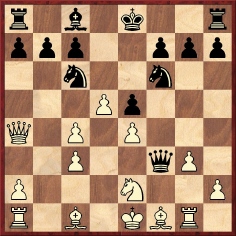
The question asked in that item concerned the identity of Black, who, Pachman had claimed, won with 1…Nxe4 2 dxc6 Qf2+ 3 Kd1 Qxe2+ 4 Bxe2 Nxc3+. We noted that the position was published with the meagre caption ‘N.N. – Burn’ on page 322 of Moderne Schachtaktik, volume 1 (Berlin, 1961) and on page 195 of the Czech version Taktika Moderního Šachu (Prague, 1962), whereas it was absent from the heavily-abridged English translation of Pachman’s work, i.e. Modern Chess Tactics (London, 1970). But, we wondered, was Black really Amos Burn (or, perhaps, one of the Byrne brothers)?
Then in C.N. 2843 Christian Sánchez (Rosario, Argentina) reported that he had found this game in a database: 1 e4 d5 2 exd5 Nf6 3 d4 Qxd5 4 c4 Qe4+ 5 Ne2 e5 6 Nbc3 Bb4 7 Qa4+ Nc6 8 f3 Bxc3+ 9 bxc3 Qh4+ 10 g3 Qh5 11 d5 Qxf3 12 Rg1 Ne4 13 dxc6 Qf2+ 14 Kd1 Qxe2+ 15 Bxe2 Nxc3+ 16 White resigns.
After 12 Rg1 the position is the same as the one given by Pachman, except for the absence of a white pawn on e4. The heading to the game in the database was ‘Amateur – Burn, 1969’.
In that latter C.N. item (see pages 3-4 of Chess Facts and Fables) we then commented: ‘Armed with this information, we expected to find the score in a contemporary source, whatever “contemporary” may mean in this context (evidently not 1969, since Pachman’s book was published in the early 1960s), but we have not been successful.’
Now Mr Sánchez informs us:
‘I can provide a more “solid” source for the game. It appeared on pages 105-106 of 200 celadas de apertura by Emil Gelenczei (published by Martínez Roca, Barcelona) – merely with the heading “N.N. – Burn” and no date or place. The fact that the date 1969 appeared prominently on the copyright page could explain why that is the year given in the heading to the game in the database.’
Below is the relevant part of that page in our edition of Gelenczei’s book:

However, Mr Sánchez points out that 1962 is a misprint for 1969. From library catalogues we note that the book first appeared in Hungarian in 1958, and it would be appreciated if any reader who has that edition could send us a copy of the relevant part.
W.D. Rubinstein (Aberystwyth, Wales) writes:
‘In baseball, the pitcher attempts to get the batter to strike out by throwing a variety of tricky pitches. One of the oldest is the “curveball”, in which the pitcher puts a spin on the baseball such that it appears to curve away from the batter and then back towards him as it travels from the pitcher’s throwing arm to home plate.
The curveball has been a part of baseball since the 1860s or early 1870s and is generally regarded as having been invented around 1867 by William “Candy” Cummings, although there are several other claimants. The first recorded use of the term “curveball” is in the New York Herald on 7 July 1874 according to page 118 of The Dickson Baseball Dictionary by Paul Dickson (New York, 1989).
It seems clear that Jackson Showalter, who was born in 1860, could not have invented the curveball.’
From Avital Pilpel (Haifa, Israel):
‘I have just interviewed the 91-year old Elizever Pe’er, who was the non-playing captain of the Israeli team at the 1960 Olympiad in Leipzig. He asked the members of every team to sign an autograph book, and as far as I can tell they all agreed.
The small (A5) brown-covered notebook has 39 pages of autographs, one per team, with the country’s name printed in Hebrew and usually with the national flag. Only 39 teams, and not all 40, are represented because Pe’er omitted to have the Israeli players sign. There are the signatures of six world champions past, present and future: Botvinnik, Euwe, Fischer, Petrosian, Smyslov and Tal. (Is this a record for a single document?) Other famous players include Flohr, Gligorić, Korchnoi, Lilienthal and Najdorf.’
From the pages our correspondent has shown us we pick those of the top two teams:
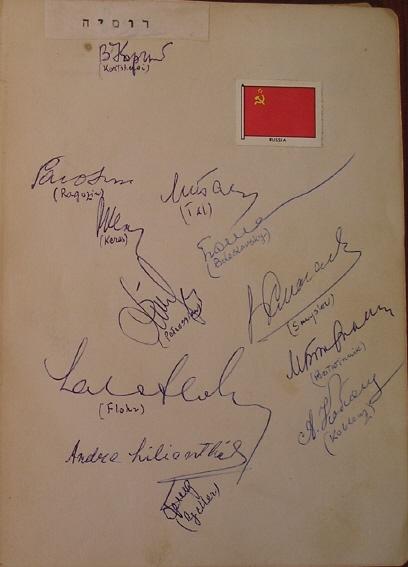
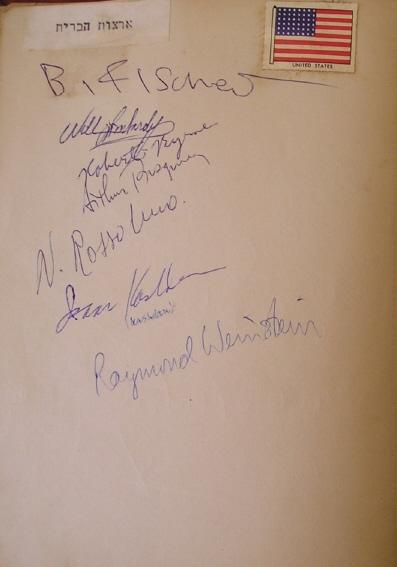
Although Ajedrez La lucha por la iniciativa by Orestes Aldama Zambrano (Barcelona, 2000) refers to Fisher and Meking on the first page of text, it is a monograph on Capablanca. His opponents include Atkeens, Berstein, Bofoljubov, Corso, Kreymbour, Kupnich, Kvitz, Rogoljubow, Rubistein, Spielman and Tartakowwer, and all this may be termed ‘doing a Bjelica’.

This is Benito H. Villegas (1877-1952) of Argentina, in a picture culled from page 496 of El ajedrez en la Argentina by José Pérez Mendoza (Buenos Aires, 1920).
Stefan Bücker (Nordwalde, Germany) writes:
‘Steinitz was very critical of Wormald’s The Chess Openings (1875). Presenting the following example, he even classified Wormald as a [writer] “so totally devoid of chess instinct as to recommend” [after 1 e4 e5 2 Nf3 Nc6 3 Bc4 Bc5 4 O-O Nf6 5 d4 exd4 6 e5 d5 7 exf6 dxc4 8 Re1+ Kf8 9 fxg7+ Kxg7 10 Ne5 Re8 11 Bh6+ Kg8 12 Nxc6 bxc6 13 Rxe8+ Qxe8 14 Nd2 Qe6 15 Qh5 Qf5
16 Qh4 Be6 17 Ne4] 17…Bb6. Here the usual move was 17…Be7. Steinitz tried to prove that Wormald’s suggestion 17…Bb6 was a mistake: “White might still continue 18 Nf6+ Kh8 19 g4 Qg6 best 20 Bf4, threatening 21 Be5 with a strong attack.” This is optimistic, since Black has 20…Kg7 21 Be5 h6, followed by 22...Kf8, which seems to be equal. If White tries 19 Bf4 (instead of Steinitz’s 19 g4), Black still has 19…c3 20 Be5 cxb2 21 Re1 Kg7.
Perhaps there are better ways to attack 17…Bb6, but I see nothing sufficiently convincing to justify Steinitz’s strong words quoted above.
Even if Steinitz were right concerning 17...Bb6, that would not mean that his own chess instinct was any better than Wormald’s. In the diagram above both Wormald and Steinitz overlooked a clear refutation: 16 Re1 (threatening 17 Re8+ with mate to follow.) 16…Be6 (what else?) 17 Qxf5 Bxf5 18 Re5, attacking both bishops.
Robert B. Wormald was not in the same class as Steinitz as a player, but his book did not deserve such harsh treatment. Besides, the whole variation today has lost much of its earlier importance. Comparing the sequence with a detailed article by Lev Gutman on the Max Lange Attack in issue 22 of Kaissiber (2005), we find that:
(a) The main line 8 Re1+ is weaker than 8 fxg7, according to Gutman. The latter move gives White an advantage, but Gutman’s analysis fills 15 pages.
(b) The reply 8…Kf8 is correct (8…Be6 would allow 9 fxg7, transposing into Gutman’s main line).
(c) 9 fxg7+ (Max Lange, 1854) is weaker than two “modern” options, 9 Bg5 (Steinitz, 1889) and 9 Ng5 (Abels and Zemsch, 1911).
(d) 10…Re8 is less precise than 10…Qf6, according to Gutman.
(e) Instead of 13 Rxe8+, 13 Nd2 would be playable.
(f) Rather than 14…Qe6 Black should play 14…Bf5 15 Qh5 Qe6 (analysis by Zemsch, 1902).
So from a modern perspective Steinitz and Wormald were discussing an irrelevant line. But are modern opening books so much better? The main line usually consists of three mistakes in a row: 8 Re1+ Be6 9 Ng5. According to the article in Kaissiber, Steinitz and Wormald at least had the second move right: 8...Kf8.’
Our earliest known occurrence of the word chessist was the following:
‘The centralisation of the chess resources of this country is a subject that must sooner or later recommend itself to all energetic English chessists as one that deserves to be taken in hand with a view to its realisation.’ City of London Chess Magazine, July 1875, page 163.
Now, though, Joost van Winsen (Silvolde, the Netherlands) has found the following in James Mason’s column ‘The Chess Board’ on page 284 of The Spirit of the Times, The American Gentleman’s Newspaper, 1 November 1873:
‘Every chessist should consider it a duty, if not a pleasure, to do his utmost to advance the interests of the “king of games”, that peerless amusement in which he has whiled away so many hours in the past, and which he regards as an unfailing source of delights in time to come.’
Mr van Winsen comments that the whole article, written when Mason was 23, is of interest:
‘An American Chess Congress
It is safe to say the “cause” never presented a more flattering appearance than it does at the present time – nor was the outlook ever so cheering. At first sight it looks as if the period of the “Morphy excitement”, properly so called, might be cited as an exception to this statement; but a little reflection will convince us that it is an apparent exception only. It is true that immense enthusiasm was aroused by Morphy’s really wonderful achievements, but that enthusiasm owed its being to feelings of a national, rather than to those of a Caissan character and derived its support from an affected, rather than a true, perception of the utility of chess itself. Morphy’s victories over the greatest foreign masters were regarded as a national triumph. The popular heart was fired, and chess became the rage from one end of the country to the other. It suddenly became fashionable to play chess, and consequently everybody wanted to play it. Chess columns were started in half the newspapers in the land; chess clubs sprang up like mushrooms – we went to sleep ignorant of the names of the pieces and awoke a nation of chessplayers. Now something analogous to all this would have occurred had Morphy been a bagatelle player, or a skittle player. The sudden and unprecedented, not to say wonderful, interest manifested by people in the game of chess was not created by anything in the game itself – by any popular appreciation of its many and strong claims to be ranked as the chief amusement of civilization – but was solely attributable to the fact that a young American had beaten the “world” at it. The fact is chess was used as a vent for the almost superabundant vanity of the nation. Everybody is aware of the consequences. The reaction came and came with a vengeance – hastened perhaps by the civil war – and for a long period chess with us might nearly be regarded as one of the “lost arts”.
But we are now upon better times. The spirit abroad draws its inspiration from the game itself, as a genuine healthy spirit should. On every side there are evidences of an increasing interest in, and an increasing admiration of, the science and art of chess-play which are creditable to our day and country. We have a chess literature unexcelled, if equalled, by that of any other nation. We have many flourishing chess clubs, many fine players and very many fine problematists. But here we stop, and compared with other countries in which chess flourished to greatest advantage the stoppage is in the highest degree unfavourable to us. We stop in this: We have no organization. We should not indolently content ourselves with the present condition of chess, while a great opportunity to improve it exists on the one hand and a certainty that, if we don’t improve it, it will retrograde, meets our eye on the other. It may not be generally admitted, but it is not the less a fact, that the popularity of chess depends very greatly upon the skill and number of its foremost players. Of course the term popularity is here used restrictively. Chess can never be popular as the race-track, the ball field or the billiard table is popular. There is absolutely nothing in it that appeals to the eye. It is, as it were, a contest of mind against mind – a conflict of ideas. Everyone conversant with chess knows that even the board and men are not essentials to chess-play. Many persons can and do play chess without them. In point of fact they are aids to the memory and nothing more. The moves in a game record but a modicum of the conceptions of the players – the combinations which actually take place on the board being but a small part of those which occur in the mind. All this being so, and, further, the element of chance being absent, it is clear that chess can never be popular in the full sense of that word. But, though chess may not become popular, it may become a subject of interest to the great mass of the thinking community. Though lovers of the game can scarcely hope to see the day when thousands will flock to witness a match between two or more great players, yet they may reasonably look forward to a time when chess will occupy a position in the public mind out of all comparison with its present one. Now, the popularity of chess depending so much upon the number and skill of its exponents, the duty of all having the interests of chess at heart is plain and not to be mistaken. That duty may be expressed in one word, namely, organization. By organization alone can the standard of play be raised, can first-rate players be produced, and the interest of chess be efficiently and vigorously prosecuted. The advantages of organization are so numerous and varied, its benefits are so immediate and abiding, that it is really a mystery why chessplayers, of all people in the world, ignore it so utterly and complacently. Every chessist should consider it a duty, if not a pleasure, to do his utmost to advance the interests of the “king of games”, that peerless amusement in which he has whiled away so many hours in the past, and which he regards as an unfailing source of delights in time to come. But if he does not feel disposed to do his utmost, he should at least do something. For instance, let him perform the not very arduous feat of becoming a member of the chess club existing in his vicinity; or, if no club exists there, let him make a gentle effort to organize one; or, let him try his hand at evangelizing the heathen – enlightening his benighted friends somewhat as to the nature of the game and teaching them how to play it. Every community of consequence should have its chess club, every State its association; and, above all, a national association should be a fact accomplished if we are to improve or even maintain our present position in the ranks of chess-playing nations. In 1876 America will hold up for the admiration of the world her products and manufactures; her inventions and works of art will challenge the admiration of the human race, for her progress in the “useful”, the “beautiful” and the “true”. In less than three years from today the grand results of the labours of humanity, in thought and in action, will be on exhibition in the city of Philadelphia – if chess, one of the most wonderful productions of the human mind fail to have a place in that exhibition, it will be incomplete. And, right here, we may say what we should perhaps have said before. We may say that we received a communication from a gentleman well and favourably known in the “chess world” asking our opinion as to the feasibility and expediency of a national tournament in the United States during the season 1873-74. We – but we shall let him speak for himself.
“To the Chess Editor of the Spirit of the Times
Sir: – If you desire you can publish the fact that I will (though a poor man) contribute without fail fifty dollars (50) towards a National Tournament in 1873 or 1874. I should prefer having it held in Boston or Washington, but will contribute the above amount no matter where it is held. I think if you take the matter in hand and publish the bona fide offers you can get up a grand National Tournament before Spring.
J.A.C. [James A. Congdon]”
We reply to J.A.C. that a general tourney of American players to be held in 1873-74 is not only feasible and expedient, but absolutely necessary, if the International Congress of 1876 is to be a success. There is no time to be lost. Let all chessplayers unite in this thing and we shall see it accomplished. By means of it, an association of American chessplayers may be brought about that will render the failure of the International Congress an impossibility instead of a certainty as it seems to be at the present time. What say our friends in New England? and in Pennsylvania? and in the West? and in the South? We should be pleased to publish the names of all who may wish to contribute toward this undertaking and shall give all communications on the subject our undivided attention.’
Past items (see page 192 of A Chess Omnibus and pages 130-131 of Chess Facts and Fables) mentioned that Gerald Abrahams and André Chéron wrote monographs on both chess and bridge. Another person in that category is James Cruickshank Henderson Macbeth, who co-authored with F.J. Marshall Chess Step by Step (New York, 1924) and also penned Common Sense in Auction Bridge (1924) and Auction Bridge Simplified (1925).
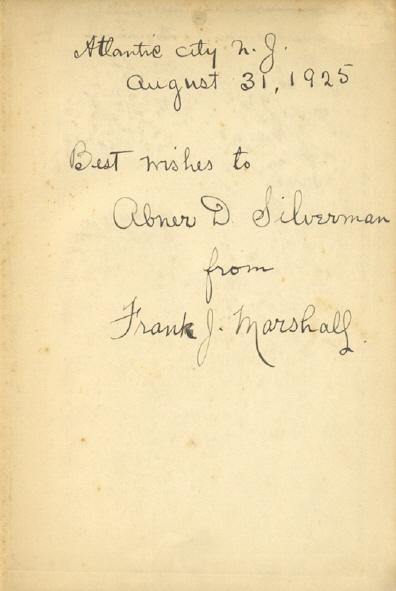

From Hermann Helms’ biographical note on pages xii-xiii of Chess
Step by Step:
‘J.C.H. Macbeth was born in Scotland, and educated at Aberdeen University. He inherited a taste for chess, as both his father and grandfather were good players, and while in his early 20s he won the championship of the Aberdeen Chess Club for three years in succession. He was invited to take part in the great match between England and Scotland in 1903, and justified his selection by winning both his games.
For several years he was one of the leading figures in Scottish chess circles ...’
What is to be made of these claims on Macbeth’s behalf?
C.N. 3332 (see page 255 of Chess Facts and Fables) pointed out that page 55 of Chess: How to Improve Your Technique by Frank Brady (New York, 1974) incorrectly stated that en prise is ‘pronounced en-pree’, whereas the second word rhymes, more or less, with ‘keys’.
The mispronunciation seems particularly prevalent in United States sources, as a web search for ‘on pree’ will show. As regards chess books, the most recent occurrence of this error that we have seen is on page 167 of Portable Chess Coach by Judee Shipman (New York, 2006).
As usual, the Collins English Dictionary is impeccable:

Tartakower’s poetry has been discussed in C.N.s 3787, 3833, 3863, 4089 and 4278, but what is known about his non-chess prose output? Perhaps a reader can expand upon what Harry Golombek wrote on page 69 of Chess Treasury of the Air by Terence Tiller (Harmondsworth, 1966):
‘He produced monographs on all kinds of philosophic and scientific subjects. I remember that once, for instance, he was engaged on a work dealing with the relationship between colours and sounds.’
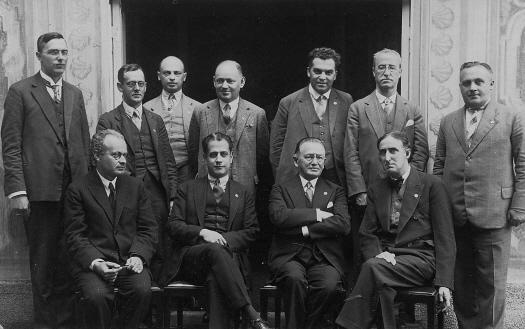
Rudy Bloemhard (Apeldoorn, the Netherlands) owns a postcard of the famous group photograph of Bad Kissingen, 1928 signed by all the participants, as well as by Boris Kostić. Underneath his signature is that of a person as yet unidentified:

Page 83 of The Art of Chess Playing by E.V. Mitchell (New York, 1936) provided two quotes by Ruskin about chess, from Letters of John Ruskin to Charles Eliot Norton:
‘Herne Hill, Saturday morning,
St Valentine’s, 1874...I’m going to drive up the hill to the Crystal Palace, and I shall play games of chess with the automaton chess player. I get quite fond of him, and he gives me the most lovely lessons in chess. I say I shall play some games, for I never keep him waiting for moves and he crushes me down steadily, and my mind won’t be all in my play today, any more than Henry 8th at the end of the play – only the automaton won’t say, “Sir, I did never win of you before”.’
‘Corpus Christi College, Oxford
15 February 1874... I played three games with the automaton – not bad ones, considering. Two others played him, also, – an hour and a half went in five games.’
Also on the subject of Ruskin, Morgan Daniels (Bury St Edmunds, England) submits the following item from page 5 of The Times, 25 June 1885:
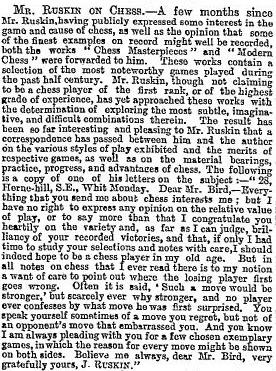
Another reader who has sent us a newspaper cutting, a piece of fantasy, is Pierre Bourget (Beauport, Canada). It comes from the Morning Chronicle (Quebec) of 19 April 1893:
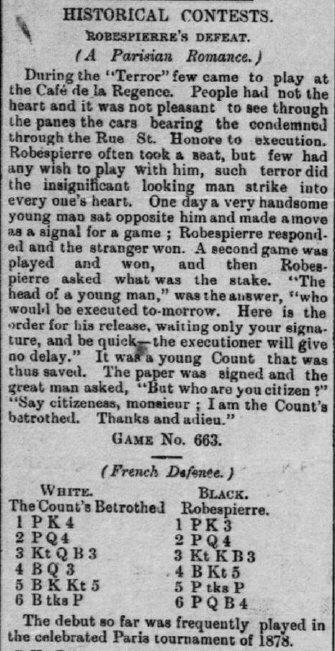

For another version of this story, see pages 161-163 of Chess Pieces by Norman Knight (London, 1949).
David Cohen (Toronto, Canada), who runs the Canadian Chess website, informs us that no Canadian chess museum was ever created.
It has not yet been possible to determine what happened to Frank Anderson’s prize at the 1954 Olympiad (C.N. 4445).
Quite a few readers took up the challenge, but the definitive line-up in the San Sebastián, 1911 group photograph remains to be established.
The subject was raised in C.N. 4447 after Michael Negele (Wuppertal, Germany) mentioned to us that the caption (see below) in the German edition of the tournament book (Berlin, 1911 and Leipzig, 1919) has only 15 names, whereas 17 individuals are visible. Of the participants, Schlechter and Důras are unmentioned.

For the illustration in C.N. 4447 we used the French edition of the tournament book (Paris, 1911):
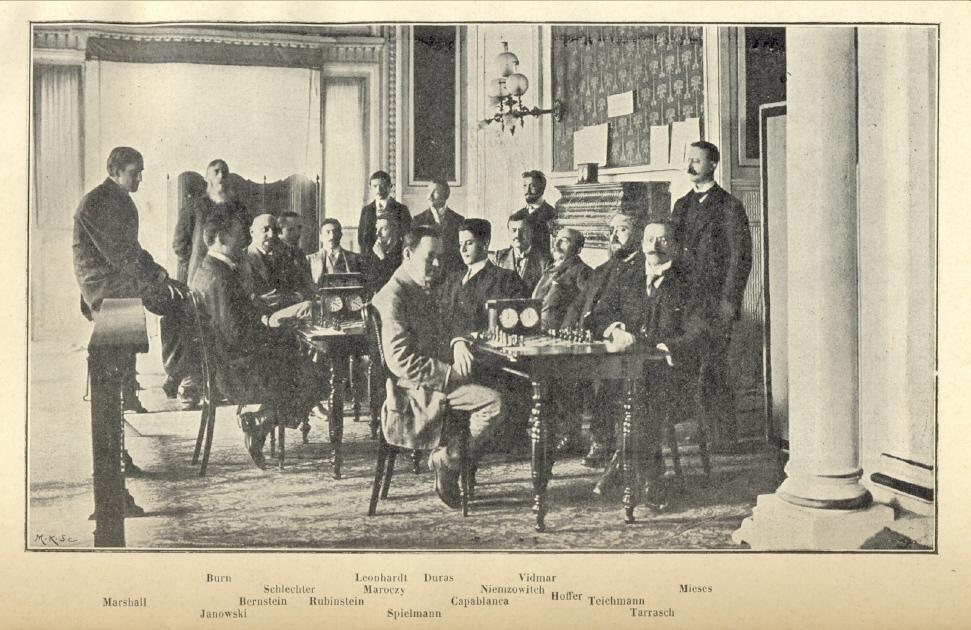
The same caption (17 names) appeared in the June 1911 issue of La Stratégie, but the player identified as Důras is evidently Leonhardt, and the figure on Bernstein’s left looks more like Důras than Schlechter. That, though, would mean that Schlechter was absent.
In the detail below, the figure on the right is clearly recognizable as Leonhardt (for comparative purposes, see the well-known group photograph of the following year’s San Sebastián tournament), but we cannot identify the person on the left.

Our conclusions (i.e. Důras on the left of Bernstein, and ‘unknown’ for the person on Leonhardt’s right) correspond to the caption supplied by Richard Forster on page 796 of Amos Burn A Chess Biography. They also match the information given by Vidmar, who provided only 16, and not 17, names when presenting the photograph opposite page 160 of his autobiography Pol stoletja ob šahovnici (Ljubljana, 1951):

From Nathan Bauman (Seoul, South Korea):
‘Regarding the first chess computer, a king and rook versus king problem-solving machine invented by Leonardo Torres y Quevedo (1852-1936), I would draw your attention to a recent article I have written, “A New Photograph of ‘El jugador ajedrecista’, the World’s First Chess Computer”.
I wonder whether any other pictures or clips can be found. There is very little visual material available on the Internet, and what does exist seems to have been conflated with a machine invented by Torres y Quevedo some years later.’
Any references that readers can provide will be appreciated. In the meantime, we note that some illustrations of Torres’ invention (a photograph and four diagrams) appeared on pages 227-229 of that much-neglected book Chess: Man vs Machine by B. Ewart (London, 1980).
Although Ewart noted that Torres’ machine (‘the first purely mechanical chess player’) was introduced to the public at the Sorbonne in Paris in November 1915, a number of chess computer books give the date of its invention as 1890. See, for example, page 11 of Computer Chess by L. Pachman and V.I. Kühnmund (London, 1986) and page 20 of I giocatori artificiali by P. Ciancarini (Mursia, 1992).
Concerning the subsequent generation (in terms of both computers and the Torres family), below is an item from page 94 of the February 1951 CHESS:
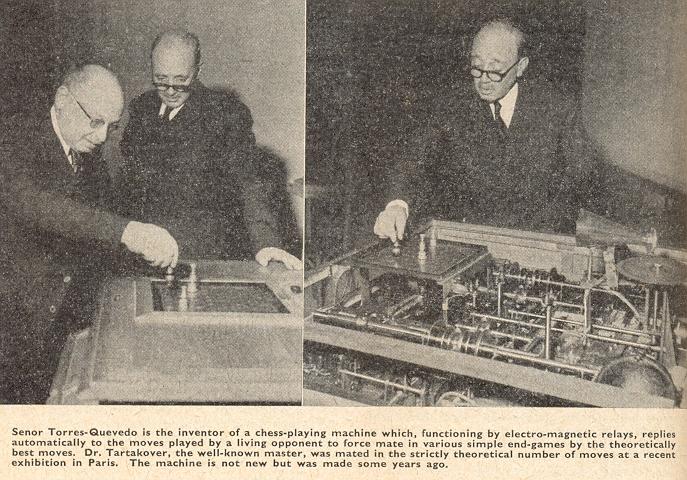
We are seeking an expert on the history of draughts/checkers who could be consulted on a few factual matters. Can any reader recommend such an expert?
Page 277 of Kings, Commoners and Knaves quoted the following from page 311 of CHESS, 20 May 1965:
‘The spectators enjoyed this game – or at least they enjoyed telling the bottle-weary players of their missed opportunities!’
This reminds us of the conclusion of a review by David Hooper of two books by Jeremy Gaige on page 32 of the October 1971 CHESS:
‘... we should like to be reassured that he has sufficient years ahead of him in which to complete his Herculean tack!’
Page 328 of La Stratégie, 15 November 1901 had a three-move problem with the heading ‘A pussing fancies’.
And finally, from page 253 of William Steinitz, Chess Champion by Kurt Landsberger (Jefferson, 1993):
‘All the travellers came to talk or play chess with Steinitz, but they also contributed to the growth of cheese in America.’
Who is this?
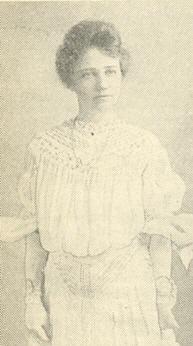
Below is the text of C.N. 2664 (see also pages 364-365 of A Chess Omnibus); it raised a matter on which no further details have yet been found:
Page 224 of the September 1963 Chess Life had this box announcement:
‘Want to Get Published?
Bobby Fischer is compiling his early games, 1955, 56 & 57, for publication. He is missing quite a few – and he was on the losing side of many of these. If you have any of the scores, send them to Chess Life, c/o J.F. Reinhardt, 80 E. 11th Street, N.Y. 3, N.Y.’
Is anything more known about this publication project? As ever, the call is for solid information. This is not the place for observations along the lines of ‘If memory serves, my understanding has always been that I read somewhere that maybe there was talk once of a rumour that someone perhaps mentioned an oral tradition that it may possibly have been claimed that it was widely believed that …’.
Concerning the final paragraph, other precursors of nescience include, ‘My best guess would be that ...’, ‘If I had to guess I would say that ...’, ‘I think I read or heard somewhere that ...’ and ‘The last I heard was that ...’
From page 1 of Larsen’s Selected Games of Chess 1948-69 by Bent Larsen (London, 1970):
‘It appeared that my father knew the game, and we sometimes played. When I was 12 I beat him almost every time; then I entered the chess club. At that time I also began to borrow chess books at the public library. I even found a chess book at home – nobody knew how it had got into the house. Probably the former owner had forgotten it. This book had a certain influence on the development of my play. About the King’s Gambit it said that this opening is strong like a storm, nobody can tame it. In the author’s opinion modern chess masters were cowards, because they had not got the guts to play the King’s Gambit. Naturally, I did not like to be a chicken and, until about 1952, the favourite opening of the romantic chess masters was also mine.’
Which book was it?
John Blackstone (Las Vegas, NV, USA) sends a brief report from page 3 of the New York Times, 26 June 1904. It begins:
‘Five of the masters who were competitors in the recent international chess tournament at Cambridge Springs, Penn. participated in a team match at the Brooklyn Chess Club Friday night [24 June], the sides being captained by Frank J. Marshall, winner of the international event, and Richard Teichmann, who was then finishing a three days’ engagement at the Brooklyn Club.
Marshall was in a reckless mood, chose an eccentric opening and made an unsound sacrifice, with the result that he lost his individual encounter with Teichmann at Board 1, after a long and far from uninteresting game.
Carl Schlechter, the Austrian champion, won his game from J.S. Jones, Vice President of the Western Chess Association, and A.W. Fox won from C. Jaffe. W.E. Napier and C.S. Howell were matched at the second board, and the game resulted in a draw. The match was won by Teichmann’s team on totals of five to four.’
The newspaper then listed the complete board results, but presented no moves. Mr Blackstone asks if anything further is known about the event and whether any games have survived.
The match was mentioned on page 217 of Napier The Forgotten Chessmaster by John S. Hilbert (Yorklyn, 1997), which gave the moves of Napier v Howell, but we have come across no other games. Can any reader trace them and, in particular, the Marshall v Teichmann game-score?
Capablanca’s victory as White against Janowsky at New York, 1918 (1 d4 d5 2 Nf3 Nf6 3 c4 e6 4 Bg5 Nbd7 5 e3 c6 6 Nbd2 Be7 7 Bd3 dxc4 8 Nxc4 O-O 9 O-O c5 10 Rc1 b6 11 Qe2 Bb7 12 Rfd1 Nd5 13 Nd6 Bc6 14 Ne4 f5 15 Bxe7 Qxe7 16 Ned2 e5 17 dxe5 Nxe5 18 Nxe5 Qxe5 19 Nf3 Qe7 20 Nd4 cxd4 21 Rxc6 Nb4 22 Bc4+ Kh8 23 Re6 d3 24 Rxd3 Qc5 25 Rd4 b5 26 Bxb5 Nxa2 27 Bc4 Nb4 28 Qh5 g6 29 Rxg6 Rad8 30 Rg7 Resigns) was annotated by the Cuban in My Chess Career, and the conclusion was discussed by Bruce Hayden on page 298 of the October 1951 Chess Review. A slightly different version of Hayden’s text appeared on pages 21-23 of his book Cabbage Heads and Chess Kings (London, 1960), as quoted below:
‘I myself kibitzed a Capablanca game, but by mail, and with interesting results. In the great New York tournament of 1918 one of Capa’s masterpieces was his game against Janowsky in the sixth round ...
Capa now played the neat combination 30 Rg7! and Black resigned; for after the forced move of 30...Kxg7 there follows 31 Qg5+ Kh8 32 Rxd8, and Black must lose his knight (32...Nd5) to prevent the two mating threats of Qf6 and also Qg8+.
Many years after, I played over the game as a youngster from My Chess Career, in which Capablanca gives it high praise and adds that “only the expert can fully enjoy it”. It was awarded Second Brilliancy Prize, but I spotted another brilliancy which, I thought, might have obtained the first prize.
The initial move is 30 Qg5. The proffered rook cannot be captured because of mate on the move, and the threat is 31 Rg8+ Rxg8 32 Qf6+ Rg7 33 Rxd8+ and mate on the next move.
The defence of 30...Qxc4 fails against 31 Qf6+ Rxf6 32 Rxd8+, forcing mate; and 30...Nd5 31 Rg7 is sufficient.
When I showed this line to masters and other experts they all gave the defence 30...Qc7. But now the brilliancy really ticks: 31 Rg8+ Rxg8 32 Qf6+ Qg7 33 Rxd8!! and mate is forced again.
So I sat me down and posted off the question. This time I received a reply. You can’t post looks of surprise and disapproval through the mail.
“I have been too busy to examine the variations which you mention”, replied the (by now) ex-world champion, “but doubtless your suggestions are correct.”
It was Brian Harley who in turn kibitzed me by correspondence. His move arrived on a postcard: 30...Rd5!!
Now it appears that all White’s efforts come to naught. Try 31 Rg8+ Rxg8 32 Qf6+ Rg7 33 Qd8+! Rg8! (Black won’t oblige with 33...Rxd8 34 Rxd8+) 34 Qf6+ with a draw by perpetual check.
Whew! What a diabolical move is that rook obstruction on d5. But then what else can one expect from a famous problem composer?
This seems to be Black’s defence all right, but later Joseph Limarzi, of the Italian Embassy in Washington, DC, took a hand at kibitz by mail. His move takes advantage of the black rook on d5, thus, after 30 Qg5 Rd5
31 Qh6.
This threat of immediate mate now not only counters the defence of ...Qe7 because of the loss of the rook on d5 but also sidetracks neatly any ideas of Black’s for a later sacrifice ...Qxc4.
Against the two defences (a) 31...Rg8 and (b) 31...Rf7 Mr Limarzi’s analysis runs: (a) 32 Rxg8+ Kxg8 33 Qe6+, winning a piece after the black king moves, by 34 Rxd5, for if 34...Qxc4 the black queen is lost by discovery after the rook checks. (b) 32 Rxd5 Nxd5 (not 32...Qxc4 33 Rd8+) 33 Rd6 (attacking the knight and threatening also 34 Rd8+), 33...Nf6 34 Rd8+ Ng8
35 Qf6+! and forces mate prettily.
Nevertheless, though all this is interesting analysis Capa was correct to clinch the win simply with the lucid elegance for which he was famous.’
In Cabbage Heads and Chess Kings Hayden did not mention an editorial interpolation in his Chess Review article: the suggestion of 30...Rd5 31 h3.
Capablanca also annotated the game, briefly, on page 20 of the New York, 1918 tournament book, as follows:
6 Nbd2: ‘d2 seems to be the better post for the queen’s knight and an improvement over the old method of proceeding against this system of defense.’
10 Rc1: ‘Here 10 Nce5 might help to hinder the development of the queen’s bishop.’
13 Nd6: ‘The object of this move is to force the bishop to c6, where it is not well placed.’
14...f5: ‘This is a two-edged sword. If he cannot soon play ...f4 or ...e5, a weakness is created which may prove fatal.’
16...e5: ‘Apparently very strong, but really leads to the loss of the game.’
19...Qe7: ‘Against any other move White would continue with 20 Bc4.’
20 Nd4: ‘The maneuvering of this knight has been really extraordinary, this being his seventh move, and it is now clear he has accomplished quite a bit.’
26 Bxb5: ‘Attacks by 26 Qh5 or 26 Rh4 are inferior to the text move.’
28...g6: ‘White threatened 29 Rh4.’
29 Rxg6: ‘A seemingly possible brilliancy beginning with 29 Rd7 is spoiled, after 29...gxh5 30 Rh6, by 30...Rf7, etc.’
In My Chess Career Capablanca wrote:
‘This game is remarkable because it would be hard to say which move lost the game, though it is probably ...f5 or ...e5, and most likely the former.’
It may be considered strange that in neither My Chess Career nor the tournament book did Capablanca criticize 7...dxc4, although innumerable other contemporary sources also passed over that move in silence.
In the quotations above from Hayden and Capablanca the moves have been converted to the algebraic notation.
Below is an inscription by Harry Golombek to Bruce Hayden in a copy of Capablanca’s Hundred Best Games of Chess in our collection, as well as Hayden’s signature (on a letter to us dated 1 March 1978):
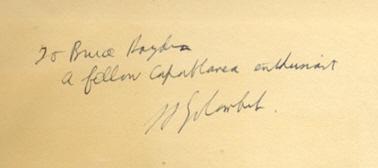
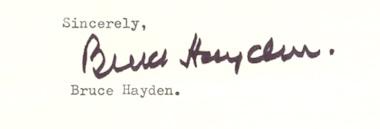
Michael Clapham (Ipswich, England) reports that he recently acquired this photograph of Géza Maróczy:
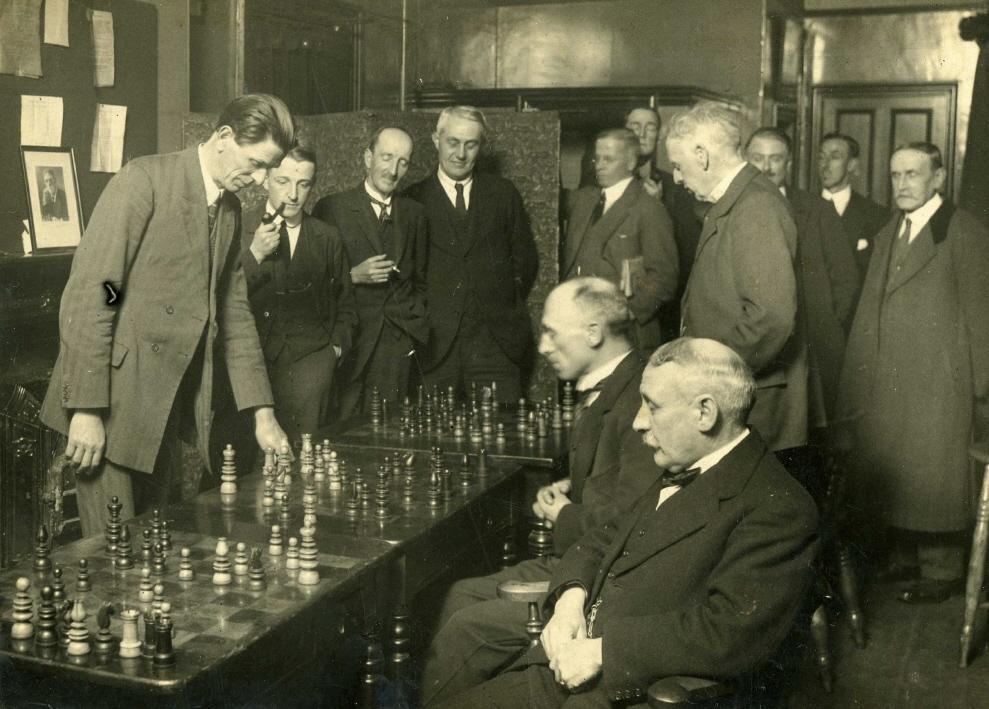
Our correspondent wonders whether the ‘old English’ chess pieces provide a clue concerning the occasion. In this connection, we note the framed portrait of Amos Burn on the far left.
From Claes Løfgren (Randers, Denmark):
‘The book that influenced the young Bent Larsen’s choice of openings was Kan De spille Skak? by Andreas Nissen (Copenhagen, 1919). A second edition was published in 1923. The full introduction to the King’s Gambit (pages 81-82) reads:
“This important and enormously interesting opening is age-old and comes from Italy. In the language of this country ‘dare il gambetto’ means to put a leg forward. The opening was already referred to in a 1561 work by Ruy López. The King’s Gambit is a gigantic opening and demands a free spirit. It roars like a storm, and only giants can defy it. Nothing shows the impotence of the present day more than the fact that nobody believes himself capable of playing the King’s Gambit any longer. The chess masters shun it like the plague. In the King’s Gambit the chess spirit rises to dizzying heights, where the modern pawn technique apparatus fails like a bad motor.
Morphy valued the King’s Gambit very highly, and it was a fearful weapon in his hands. Adolph [sic] Anderssen immortalized it in his famous game against Kieseritzky – but then Anderssen was not a master whose only concern was points, points and more points, preferably paid for piece by piece by a business-wise tournament committee.”
Nissen was obviously an inveterate romantic and had little good to say about closed openings or the tournament players and praxis of his day. Often he was altogether unable to hide his contempt. About the Caro-Kann he commented on page 100:
“This opening is even worse than the ‘Sicilian Game’ and leaves all the initiative to White. It was introduced into playing practice by the Viennese player Kann, while the German Caro messed about with it, although it cannot be claimed that he improved it ...”
On the same page he wrote of the variation 1 e4 c6 2 c4:
“It cannot be asserted that with the move 2 c4 White obtains anything at all. He indicates with this move that he is as big a coward as Black, who, terrified by the sight of White’s first move e4, tremblingly drags his c-pawn to c6. The opponents match each other well.”
Andreas Nissen (1881-1950) wrote other manuals for beginners and books on the endgame, and he edited the chess column in the newspaper Berlingske Tidende. In his obituary on page 146 of the August 1950 Skakbladet “E.C.” characterized him as follows:
“... with Nissen, the Copenhagen Chess Club has lost one of its old, esteemed members, a gifted and well-informed man, an ardent chess enthusiast, and a splendid attacking player of the old school. He was devoid of ambition in chess, and rather sought in the game the satisfaction of a strong sense of chess aesthetics and need for excitement – circumstances which may explain why, despite his unquestionable chess talent and theoretical knowledge, he never reached the top as a practical player ...”’
Pages 17-18 of Kings, Commoners and Knaves had the following position from page 365 of the September 1904 Revue d’Echecs (which had taken it from the Melbourne Leader), the players being unidentified:

Black won with 1...g6 2 Nh4 Kg8 3 Nf3 (Richard Forster remarked, ‘White should force a draw with 3 Qd3 Qe1+ 4 Kh2 Ne4 5 Qc2 Qxf2 6 Qxe4 Qxh4+ 7 Kg1 Qxg4 8 Qe8+, etc.’) 3...Ne2+ 4 Kh1 Qh8+ 5 Nh2 Ng3+ 6 fxg3 fxg3 7 Qg1 g5 8 White resigns.
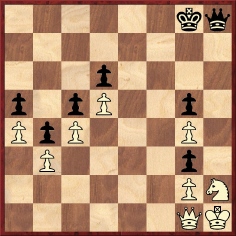
Now John Hilbert (Amherst, NY, USA) has found that the position was given in the Pittsburg Dispatch of 11 July 1904 by W.E. Napier, who wrote:
‘The following delicate bit of end play is from the folio of Philip Richardson, who was identified for many years with Brooklyn chess.’
From Christian Sánchez (Rosario, Argentina):
‘On the Internet I have found two reliable Spanish sources for information about the chess machines. One is a webpage of the Torres Quevedo Museum, where the two prototypes are preserved; there are pictures of both Ajedrecista machines. The other is an article by González Redondo; it has some illustrations of the first Ajedrecista and allows a chronology of the inventions to be drawn up:
1912: Leonardo Torres Quevedo began construction of the first Ajedrecista.
1914: The first Ajedrecista was exhibited in Paris.
1920: The second Ajedrecista was built by Gonzalo Torres Quevedo, under his father’s direction.
1922: The second Ajedrecista was exhibited in Paris.’
Calle Erlandsson (Lund, Sweden) points out that in 1955 Spain issued a postage stamp depicting the inventor:
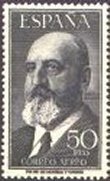
We note that the stamp was one of the illustrations in the section on the Spaniard on page 125 of Persönlichkeiten und das Schachspiel by Beat Rüegsegger (Huttwil, 2000).
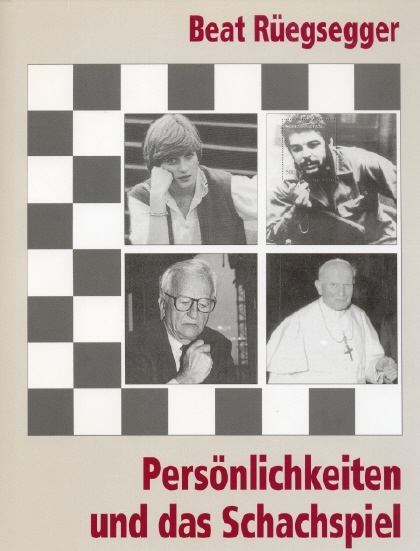
Edward Hamelrath (Dresden, Germany) draws attention to a recent chess article by Philip E. Ross in the Scientific American which is available on-line.
As regards the statement attributed to Capablanca that he saw only one move ahead but always the correct one, we refer readers to C.N. 2085 (see page 325 of Kings, Commoners and Knaves), where a correspondent noted Al Horowitz’s claim that the words were said not by the Cuban but by ‘New York’s East-side pride’, which suggested Charles Jaffe.
Now we see that in an earlier source (Chess Review, May 1946, page 34) Horowitz named Jaffe:
‘Apropos is the story of the game between the invincible Capablanca and Charles Jaffe, pride of the East Side. Capa forgot he was invincible: he lost. A reporter who was present asked the Cuban, “How far do you see ahead?” Capa replied impressively, “About ten moves”. Then the reporter went over to Jaffe: “How far do you see ahead?” Much to everyone’s surprise, the reply was, “Only one move”. This didn’t make sense. “How could a player who can see only one move ahead defeat another who can delve so deeply?” Here Jaffe explained: “I see only one move ahead, but always the best move.”
That is sufficient.’
Whether these alleged exchanges ever occurred (i.e. after Jaffe’s
win over Capablanca at New York on 2 February 1913) is far from
clear, but perhaps a reader could, on the off chance, look in the
press of the time.

This photograph (see C.N. 4473) is of Mrs Showalter, from page 138 of the December 1904 American Chess Bulletin. The following page described her as ‘without doubt the strongest player of her sex in America’ and reported:
‘Mrs Showalter comes of a prominent Kentucky family, but was born in the state of Missouri in 1872; although her maiden name was Nellie Love Marshall, she claims no family relationship with the new champion bearing the same surname.’
From page 7 of the January 1894 BCM:
‘She is only 22 years of age and was married to him [Jackson Whipps Showalter] at 16. Soon after this event her husband taught her the moves, and then gave her the odds of the queen; but she progressed so rapidly that he cannot now give her the knight, and she has won two games of Mr Lasker at that odds. Not long ago, at Kokomo, Indiana, she played four games on even terms with Mr Jackson, the champion of that State, with the result that she won three and the other was drawn. She is said to be very handsome but, if so, the portrait of her in the New York Recorder does not do her justice ...’
A photograph of their son, Freeman Showalter, who was born in 1895, was published on page 228 of the November 1918 American Chess Bulletin, where he was described by J.W. Showalter as follows: ‘He plays a very good, unpolished and natural game, but without any book training or knowledge acquired from books at all. I think he has considerable talent, in fact, but, of course, undeveloped.’
The obituary of an elder brother of Jackson Whipps Showalter, Judge John William Showalter, was published on page 312 of the January 1899 American Chess Magazine and stated that he was ‘a devoted follower of the game of chess’ and that ‘he taught the moves of chess to Jackson W. Showalter when the future champion was eight years of age.’
Mr Jones runs a typical bookshop which has just a few chess volumes on its shelves. Not a chessplayer, he cannot know whether he is offering a helpful selection to potential customers or whether he has a hit-and-miss assortment, perhaps even including books which are useless or worse.
It would certainly be worthwhile for Mr Jones to be given a brief, extremely select, list of the very best chess books in various fields (e.g. a first manual on the game, an introduction for children, a general overview of the openings and a lucid anthology of annotated games). Having seen no such authoritative list, we plan to compile one (featuring books in English which are in print). It will be rigorously independent and objective, and only titles which meet the highest standards will be included.
Readers are invited to send in proposals, bearing in mind that the intention is to focus on the broad market and not on specialized works of primary interest to, for instance, the historian. Authors and publishers are welcome to put forward their own books to us for consideration, and such suggestions will be treated confidentially. No book in which we have had any personal involvement will be mentioned.
The goal is gradually to draw up a short (though, we hope, prestigious) list of books which Mr Jones could order with confidence to ensure that his shelves offered customers the optimum choice. To launch the project, we reiterate here our nomination in C.N. 2546 (see page 190 of A Chess Omnibus) concerning the best introduction for beginners: The Complete Idiot’s Guide to Chess by Patrick Wolff. Unless readers have a more convincing proposal in that category, Wolff’s volume will shortly be the first entry in the Very Best Chess Books list.
David Lovejoy (Mullumbimby, NSW, Australia) suggests that the Robespierre item given in C.N. 4467 may have been the source for Tartakower’s poem ‘1793’ presented in C.N. 4278.
In the section on elementary mates in his Bréviaire des échecs (page numbers vary according to the edition) Tartakower mentioned Raymond Roussel’s work on setting out a formula for winning the king, bishop and knight versus king endgame. A detailed explanation of the system had previously been supplied by Tartakower in L’Echiquier, 28 November 1932 (pages 1892-1895) and 28 January 1933 (pages 1950-1951).

We have found no full game-scores involving Roussel, but on
page 52 of the 23 March 1933 issue of the Belgian magazine
Tartakower annotated the ‘fin d’une partie analytique’
(Paris, January 1933) between Romih and Roussel.
Tartakower also wrote an article entitled ‘Raymond Roussel et les Echecs dans la littérature’ on pages 11-14 of the January-February 1933 issue of Les Cahiers de l’Echiquier Français.
It might be an exaggeration to call Roussel, who was born in Paris in 1877, a prominent literary figure, but long after his death his renown as a novelist, playwright and poet grew again, after publication of a biography by François Caradec. The English edition (London, 2001) recently came our way, and we note that the bishop and knight endgame matter is discussed in much detail on pages 324-327. ‘Roussel-worshipper’ is how page 326 describes the late chess author François Le Lionnais, who is acknowledged by Caradec for assisting with the book.
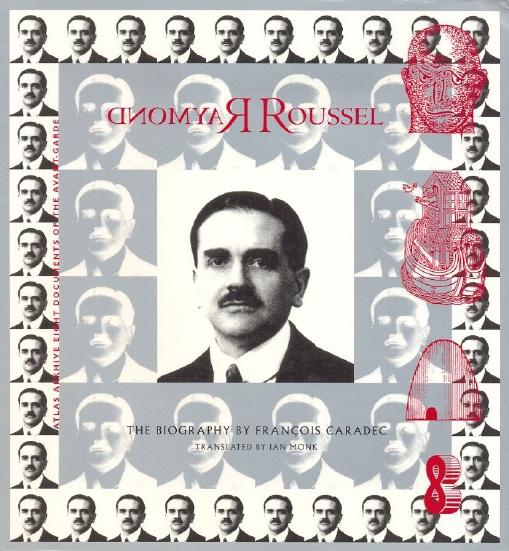
Pages 299-300 relate that in September 1931 Roussel ‘decided to acquire a grave in Père-Lachaise cemetery’ in Paris and that the undertakers ‘designed a vault with sides measuring 11.6m, containing 32 cells (eight rows of four cells)’. Caradec adds:
‘The dimensions of the vault that Roussel was to occupy alone are astounding: 32 cells. Was he thinking of a chess board? Doubtless so, when he found out that the word case is the French term for a sub-division in a vault, the same as the word for a square on a chess board. So what are these 32 squares? The 32 empty squares at the start of a game, or the 32 occupied ones?’
Roussel died in Palermo in mid-July 1933, and page 348 reports that he ‘was buried on 26 July in one of the upper cells of his vault in Père-Lachaise cemetery’.
The Steinitz-Chigorin code story was discussed on pages 243-244 of Chess Facts and Fables, and C.N. 4421 reported a similar tale regarding Capablanca and Lasker. Now we quote what is termed a ‘Chess Fact’ on page 19 of Chess Attack by Mathew Graham (Woodbridge, 2000):
‘During World War II, the Japanese confiscated chess books thinking they were secret military codes.’
The same claim can be found, without any particulars, on various lax webpages.
What exactly is the corridor mate? At first sight, the question may seem too straightforward to merit much attention, but readers are invited to ponder it briefly before proceeding.
The term was defined on page 46 of the Dictionary of Modern Chess by Byrne J. Horton (New York, 1959) as follows:
‘A mating situation in which the king can move only along the rank at the edge of the board and behind a group of pawns from where he cannot escape when attacked by a rook or queen. The rank along which the king can move serves as a closed “corridor”. The critical area of a “corridor mate” is shown in the accompanying diagram.’

This is in keeping with the presentation of the corridor mate on pages 63-74 of The Art of the Checkmate by Georges Renaud and Victor Kahn (New York, 1953); the original text (‘le mat du Couloir’) appeared on pages 66-77 of L’art de faire mat (Monaco, 1947).
Other sources which have a similar definition include page 92 of the Dictionnaire des échecs by François Le Lionnais and Ernst Maget (Paris, 1967), which gave both ‘mat du corridor’ and ‘mat du couloir’, and page 26 of Le guide des échecs by Nicolas Giffard and Alain Biénabe (Paris, 1993). See also the entries for ‘Korridormatt’ on page 144 of the Grosses Schach-Lexikon by Klaus Lindörfer (Munich, 1991) and for ‘mate del pasillo’ on pages 112-113 of the Diccionario de ajedrez by Antonio Gude (Madrid, 2005). Pages 96-97 of Disney’s Chess Guide by Anatoly Karpov (London, 1997) feature a brief section headed ‘Back Rank’, whereas the equivalent passage in the French version, published in 2000 under the title Le manuel des échecs, is labelled ‘Le mat du couloir’.
From the above-mentioned works it would be concluded that ‘corridor mate’ is merely another name for back-rank mate, but that is far from the end of matters. Chess Thinking by Bruce Pandolfini (New York, 1995) has entries for both ‘back-rank mate’ (page 36) and ‘corridor mate’ (page 78). In the former, Pandolfini wrote:
‘Chessplayers often misuse this term [back-rank mate] for any line-mate by a queen or rook along any edge of the board, whether rank or file. All queen and rook line-mates are corridor mates, but only those given along outside ranks are also back-rank mates.’
The definition of ‘corridor mate’ was given as follows:
‘A line mate by a rook or queen, given along any file or rank when possible escape squares are guarded or obstructed.’
The following definition of ‘back-row mate’ was published on page 71 of Pandolfini’s Chess Complete (New York, 1992):
‘The back-row mate falls into a larger category known as corridor mate, in which either a queen or rook mates by checking along a clear line (rank or file). Corridor mates delivered along an outside row are called back-row mates or back-rank mates, even when the outside mating row is a file.’
Reference to the word ‘file’ means that for Pandolfini a position such as the following ...
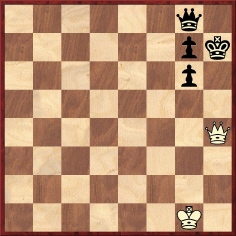
... may be called a back-row mate or a corridor mate. But is that right? And is Pandolfini correct to indicate that a corridor mate could occur even on a central rank or file? According to his explanation the following would be a corridor mate:
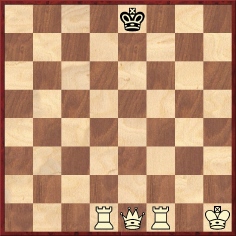
A third possible definition of the corridor mate would be a mate
only on a file, and not on a rank, but that has yet to be found in
a published source.
Finally, as regards the origins of ‘corridor mate’, how much further back can it be traced, in any language, than 1947, when Renaud and Kahn used ‘mat du couloir’?
Chess Notes Archives:
| First column | << previous | Archives [24] | next >> | Current column |
Copyright 2006 Edward Winter. All rights reserved.